[PART FOUR] INCIDENTS AND ALLEGATIONS OF CHILD
SEXUAL ABUSE |
4.1 INTRODUCTION TO INCIDENTS AND ALLEGATIONS OF CHILD SEXUAL ABUSE
Child sexual abuse is complex problem that encompasses psychological, social and legal considerations. Research and theory have sought to understand the various motivations for abuse as well as characteristic offender behaviors that lead up to and occur during abuse. In order to understand child sexual abuse, it is important to understand the motivation to begin offending (the preconditions to child sexual abuse), how child sexual abusers get children to participate in sexual activity (“grooming”), and how and why the abusers are able to maintain this course of abusive actions through rationalizations of the behavior.
When considering why men sexually abuse children and adolescents, researchers have identified a number of preconditions to child sexual abuse. These include, but are not limited to: the offender’s “emotional congruence” to youths (the link between the offender’s emotional needs and the children’s characteristics), low self esteem, deviant sexual arousal, “developmental blockage” (the failure to develop the appropriate social skills and self-confidence necessary to form effective intimate relations with adults), “situational blockage” (when an adult’s sexual interests are blocked from normal sexual expression owing to the loss of a relationship or some other transitory crisis), and disinhibition (the factors that help a child sexual abuser overcome his inhibitions so that he allows himself to abuse a child or adolescent, e.g., use of alcohol or other substances). [1] These preconditions are each variable in strength; while some abusers may act out as a reaction to transitory stress, others seem to be driven by such a strong compulsion that situational factors play only a minor role, if any at all.
In order to get the children to go along with the abuse, many child sexual abusers indulge in what is termed “grooming,” or premeditated behavior intended to manipulate the potential victim into complying with the sexual abuse. [2] Grooming tactics include verbal, emotional and/or physical intimidation, seduction, and the use of enticements such as candy, money, or other gifts. Emotional manipulation and verbal coercion seem to be the most common tactics used by offenders to groom their victims, including doing favors for the victim in exchange for sex and/or emotionally blackmailing the victim into compliance. [3]
In order for the child sexual abuse to continue, child sexual abusers often rationalize their behavior through “cognitive distortions,” or distorted thinking patterns. Like any other type of offender, child sexual abusers may subconsciously use a “neutralization technique” to defuse any feelings of remorse or guilt they have for committing the abusive act or for the consequences of that act. [4] They do so by excusing or justifying their actions, often acknowledging their guilt but not taking responsibility for the acts. Commonly, they blame the victims for their offenses or justify their offenses through the victims’ actions.
We used the extensive body of research findings that describe offender characteristics and the circumstances of childhood victimization as a guide in crafting the questions (e.g., the type of enticements used to “groom” children and to understand this sub-group of abusers.
[Notes for the previous section are collected in a note section at the end of the Web version of this report, and every reference in the text is hyperlinked to the note itself.]
4.2 SUMMARY: CHARACTERISTICS OF THE INCIDENTS OF ALLEGED SEXUAL ABUSE BY CATHOLIC PRIESTS
One of the most important tasks of this report is to provide a better understanding of the situations in which sexual abuse of children by Catholic priests occurred. The purpose of this chapter is to describe who has alleged child sexual abuse in the Church, his or her situational characteristics (e.g., age, gender and family situation), the relationship between the priest and the accuser. [period as in original] and the circumstances of the abuse (when and in what situation the abuse allegedly occurred). Through an appreciation of these characteristics, the Church would be better able to design policies aimed at removing opportunities in which such abuse could occur.
The study produced some important findings about the nature of child sexual abuse in the Catholic Church.
• Unlike in the general population, more males than females were allegedly. In fact, there was a significant difference between genders, with four out of five alleged victims being male.
• The majority of alleged victims were post-pubescent, with only a small percentage of priests receiving allegations of abusing young children.
• The allegations of sexual abuse involved a variety of sexual acts, and most of the priests involved were alleged to have committed multiple acts per victim. Indeed, much of the sexual abuse reported involved serious sexual offenses.
• According to the allegations of sexual abuse, the most frequent context of the sexual incidents occurred during a social event. Additionally, many of the priests with allegations of abuse socialized with the family of the alleged victim.
• The most common place of occurrence was the residence of the priest though incidents of abuse allegedly occurred in a wide variety of locations.
Whatever the motivation of men to sexually abuse children, the abuse is less likely to occur if there are fewer opportunities for the abuse to happen. This chapter paints a picture of priests who are friendly with the families of their alleged victims and who spend much social time with those they allegedly abused. Several of the priests allegedly bought gifts or gave other types of enticements (e.g., let the youths drive cars or took them to sporting events) to those who made allegations against them. Thus, like in the general population, child sexual abuse in the Catholic Church appears to be committed by men close to the children they allegedly abuse. Many appear to use grooming tactics to entice children into complying with the abuse and the abuse frequently occurs in the home of the alleged abuser or victim.
4.3 CHARACTERISTICS OF CHILDREN WHO ALLEGED SEXUAL ABUSE BY CATHOLIC PRIESTS
This chapter is based on survey data that describes 10,667 incidents of alleged sexual abuse of youths under 18 by a Catholic priest or deacon, at least part of which occurred between the beginning of 1950 and the end of 2002. The following steps were taken to achieve that number:
• Dioceses, eparchies and religious communities submitted 10,822 incident-level surveys based on files for individual priests and deacons who had been accused of child sexual abuse.
• Allegations determined to have been documented by more than one survey have been unified as a single incident-level file.
• 155 surveys that were submitted for allegations made about acts that occurred when the person making the allegation was 18 or older, and about alleged events that occurred or ended before 1950, or that were associated to seminarians or religious brothers not eligible for the study were deleted and diocesan/religious community totals corrected.
• Not all questions were answered on each survey; as a result, each table shows the available responses, and the totals change from table to table.
The extent of childhood sexual victimization is difficult to estimate though it is a phenomenon that has been studied extensively over the last few decades. Despite the claim by many that it occurs in epidemic proportions, most of these studies have disagreed with respect to the true prevalence figure. Prevalence estimates of childhood sex abuse range from 2 to 62 percent, depending largely upon the methodology used in the research design (including the definition of child sexual abuse, sampling procedures, type of questions asked during one-on-one interviews, and gender of the respondents). One analysis of the various studies on victim prevalence found that the overall prevalence for male children who are sexually abused is 13 percent, and the prevalence of female children who are sexually abused ranges from 30 to 40 percent. [1] This study also identified three significant explanations as to why there is such a wide range in childhood sexual victimization rates, including the number of screening questions used to identify abuse victims, the size of the sample, and the year in which the study was conducted. [2] The results of our study indicated that of all victims whose gender was reported, (Table 4.3.1) 81% were male and 19% were female.
Table 4.3.1 GENDER OF ALLEGED VICTIM
 |
98.5% of surveys reported the gender of the alleged victim.
Table 4.3.2 represents the age of the alleged victim at the time of the alleged event. If the event continued for multiple years, this table represents the age at which the abuse allegedly began. Each alleged victim is only represented once. Therefore, this table does not represent the duration of abuse or the ages of the alleged victims throughout the time they were abused. For instance, if a child was sexually abused from the age of three to nine, he or she is represented in this table at age three.
The majority of victims are males between the ages of 11-17, and just over half (50.7%) of all individuals who made allegations of abuse were between the ages of 11-14. The average age of all alleged victims is 12.6. This number has increased over time, however. In the 1950s, the average age was 11.5; in the 1960s it was 12; in the 1970s it was 12.87; in the 1980s it was 13.2; and by the 1990s it was 13.87.
Table 4.3.2 VICTIM’S AGE AT FIRST INSTANCE OF ABUSE
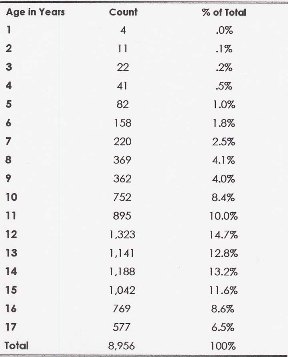 |
Eighty-four percent of surveys included the age of the alleged victim at the time the abuse occurred or at the time the abuse began. It is important to understand that in retrospective studies, particularly where there is a delay in the reporting of the events, the possibility that alleged victims did not remember the specific dates correctly must be considered. (See Section 5.1 for a review of the research on this phenome[n]on, called “telescoping.”)
The substantial majority of alleged victims of child sexual abuse, or almost four out of five, lived with both parents. Information about the residence of the alleged victim was provided on 70% of the Victim Surveys.
Table 4.3.3 VICTIM’S RESIDENCE / LIVING SITUATION
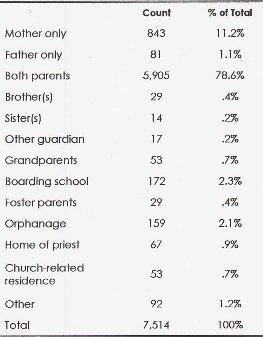 |
[Notes for the previous section are collected in a note section at the end of the Web version of this report, and every reference in the text is hyperlinked to the note itself.]
4.4 CHARACTERISTICS OF ACTS OF SEXUAL ABUSE BY CATHOLIC PRIESTS
Many efforts have been made to assess the abuse experiences of those who have been victims of child sexual abuse, from attempts to collect population data at the national level to small clinical studies done with a few survivors of sexual abuse. These studies generally tend to chronicle the types of behaviors engaged in by child sexual abusers, and primarily report percentages of the sample that experienced each form of abuse (e.g., intercourse, oral sex, fondling, pornography). A number of studies have compared male and female victims, although most of the male victim samples have been too small to allow for broad generalizations.
Looking at Table 4.4.1, it is clear that many of the allegations of abuse include more than one type of sexual act. [1] Several points are significant:
• The categories are not mutually exclusive. In other words, the abusers could have committed multiple types of abuses.
• Very few priests have allegations of only the least severe of the abuses. Only 148 priests (2.9%) allegedly committed act of verbal abuse and/or pornography offenses without more severe offenses. Only 395 priests (9.0%) allegedly committed offenses involving touching over the clothes only without also committing a more severe offense.
• Touching under the victim’s clothes is the most common act alleged. However, only 695 (15.8%) priests committed that as the only or the most serious of their alleged offenses. This means that when this abuse was alleged, it usually included a more serious offense as well.
• There are 69 incidents for which the most serious act alleged is sexual talk. These incidents represent seven-tenths of one percent, or .7% of the 9,630 surveys that reported details about the behavior that was alleged to have taken place. If sexual talk and the use of pornography are counted together, for cases where no further sexual abuse was alleged, there are 141 incidents, or 1.5% of the total.
• If talk and/or pornography use are considered together with either touching under the priest’s or victim’s clothing, and nothing more serious is alleged, the total number of such incidents is 1,196, or 12.4% of the total.
• If hugging and kissing, the removal of clothing, or masturbation is counted along with the acts outlined above, the total number of incidents jumps to 4,167, or 43% of the total.
• If incidents that include acts of oral sex or sexual penetration are counted alone, they total 3,280, or 34%.
Table 4.4.1 ALLEGED ACTS OF ABUSE, BY GENDER
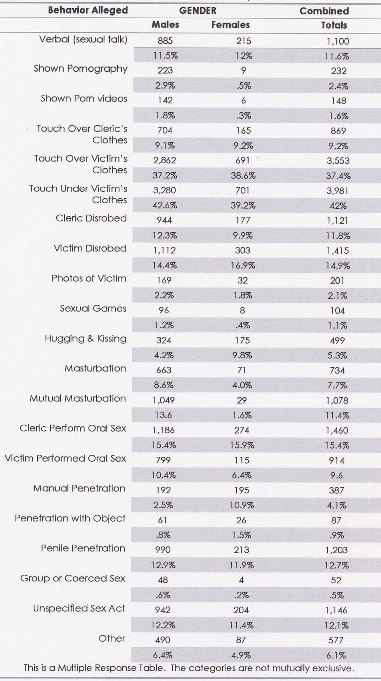 |
The category of “other” includes a wide array of behaviors, including voyeuristic and sadistic acts. Unspecified sex act refers to surveys that indicate sexual acts but do not identify particular acts. |
The majority of allegations of sexual abuse were made against priests who were accused of having committed abusive acts more than one time. Only slightly more than one quarter (29%) of the allegations involve only a single instance of abuse.
Table 4.4.2 NUMBER OF TIMES ABUSED, PER VICTIM
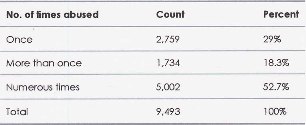 |
Question 8 on the Victim Survey asked how many times the victim was abused. The choices were ‘once,’ ‘more than once,’ and ‘numerous.’ |
Child sexual abusers who plan their abusive acts indulge in what is termed “grooming” behavior. Grooming is a pre-meditated behavior intended to manipulate the potential victim into complying with the sexual abuse. Some methods by which child sexual abusers approach and initiate sexual activity with their victims include verbal and/or physical intimidation, seduction, emotional blackmail, and the use of enticements such as candy, money, or other gifts The tactics used by offenders depend somewhat on the potential victim’s response to the tactic. If an offender encounters little to no resistance from the potential victim, he will continue to use the same tactic repeatedly. If, however, some resistance is encountered, the offender may either change the tactic and/or become more forceful in his endeavor. Table 4.4.3 shows the number of priests who allegedly threatened those who accused them of abuse, and Table 4.4.4 shows the type of threat that was used. Both tables display the information by gender.
Table 4.4.3 THREATS BY VICTIM’S GENDER
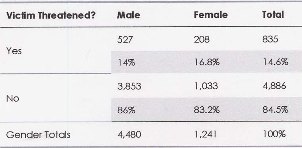 |
Approximately half of the incident-level surveys (5,761) included information on the use of threats. Table 4.4.3 is therefore based on only 50% of the reported incidents. If the number of incidents that involved a threat to the victim is expressed as a percentage of all reported incidents, 7.8% of all alleged victims were threatened in some way. |
Table 4.4.4 TYPE OF THREATS BY VICTIM’S GENDER
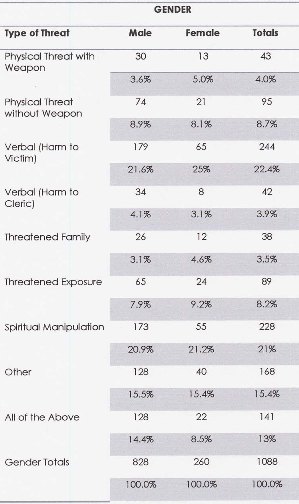 |
The use of gifts and other enticements to participate is sexual behavior is a common method of grooming potential victims. Tables 4.4.6 and 4.4.7 show the extent of and types of gifts and enticements made to alleged victims of sexual abuse by Catholic priests and deacons.. Gifts and enticements were recorded separately, and surveys showed that in 837 alleged incidents, a gift had been given. Accused priests used enticements in 1,834 incidents, or 17% of the total number of reported incidents.
Table 4.4.5 GIFTS TO VICTIMS
 |
Table 4.4.6 ENTICEMENTS OFFERED BY PRIEST
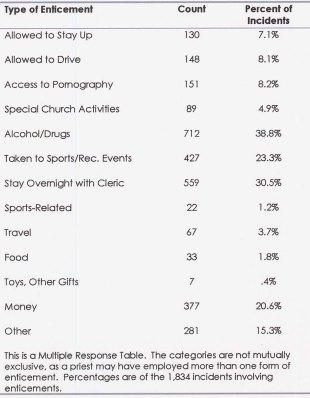 |
If the number of incidents that involved gifts is added to the number of incidents that involved enticements, the results is 2,231 incidents, or 20.9% of all reported incidents of abuse.
Some sex offenders in the general population use alcohol or drugs as a disinhibitor, or as a way to reduce their inhibitions and allow them to offend with reduced feelings of guilt and shame. Some sex offenders also offer drugs and/or alcohol to their victims to entice them to participate in sexual behavior. Tables 4.4.8 and 4.4.9 display drug/alcohol use by alleged offenders and victims respectively.
Table 4.4.7 DRUG/ALCOHOL USE BY PRIEST
 |
Question 31 on the Victim Survey asked whether the victim was under the influence of alcohol or drugs at the time of the alleged incident, and Question 32 asked about the accused priest or deacon. The study does not have detailed information about the source or type of intoxicant used. |
Table 4.4.8 DRUG/ALCOHOL USE BY VICTIM
 |
The percentages in Tables 4.4.7 and 4.4.8 are based on the total number of surveys that included answers to the Questions 31 and 32. |
[The note for the previous section has been placed in a note section at the end of the Web version of this report, and the reference in the text has been hyperlinked to the note itself.]
4.5 CIRCUMSTANCES OF THE ABUSE ALLEGATIONS
The following section describes characteristics of the alleged abuse. Information from this section was obtained through the surveys of the incidents completed for each allegation of abuse of a child by a priest or deacon. These data present contextual factors associated with the reported incidents including where and when the event took place. This section also describes the social relationships of the priests with the alleged victims' families: their Church assignment at the time the abuse was alleged to have occurred; their relationship (if any) with the family of the child involved; and any relationship with the siblings of the alleged victim.
These variables paint a picture of the circumstances surrounding reported incidents of abuse, which may aid clinicians in their understanding of such behaviors in the population of priests who abuse children. Most importantly, however, these factors may be useful in designing policies and procedures to prevent abuse from occurring in the future. Table 4.5.1 represents the decades in which the abuse allegedly occurred, or the date it began if it occurred over multiple decades.
Table 4.5.1 ALLEGED INCIDENTS, BY DECADE
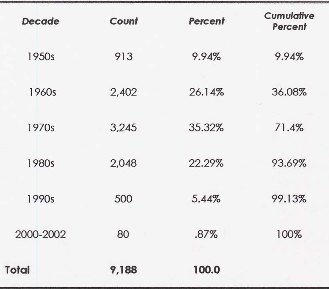 |
This table summarizes the total numbers of acts alleged by the decade when they began. It is important to note that it does not include the duration of the alleged abuse if it occurred in more than one time period. |
As Table 4.5.2 makes clear, the majority of priests, approximately 67%, were serving as either the pastor or associate pastor in their parish when the abuse was alleged to have occurred. A little over 10% of priests were resident priests at the time and approximately 9% were serving in the parish in some other capacity. Thus, the bulk of incidents were reported to have occurred in the context of the priest serving in leading capacity within the parish. Other roles, such as teacher in a school, were present as well but characterize far fewer incidents.
Table 4.5.2 PRIEST’S PRIMARY FUNCTION AT TIME OF ALLEGED INCIDENT
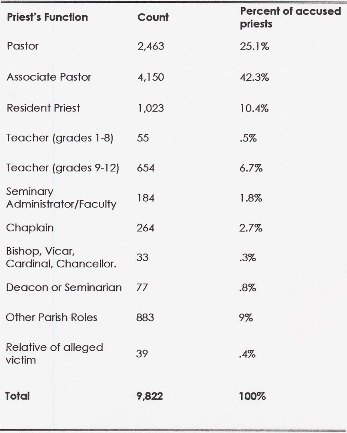 |
Some priests were serving multiple functions in the community at the time allegations were made against them. This list, however, included the primary function of the priests at the time of their allegations. |
Table 4.5.3 contains categories representing reported incidents of abuse, some of which were single- instances and others based upon multiple instances of abuse over a period of time. Therefore, some incidents reflect abuse in more than one location. However, the most commonly reported location where the incident took place was the priest’s residence/parish residence. This was the location of at least one instance of abuse for 41% of reported allegations. Incidents were reported to have occurred in the church in approximately 16% of the cases, and in the victim’s home in approximately 12% of the cases. In almost one quarter of the cases, no record of location was reported.
Table 4.5.3 LOCATION OF ABUSE
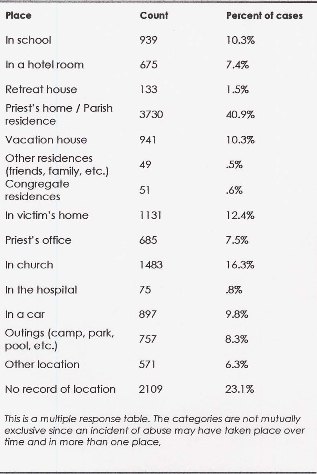 |
Table 4.5.4 shows the situations when the abuse allegedly occurred. These varied widely. Social events were the most common context (20%), followed by travel with the priest (17.8%) and visiting or working at the rectory or priest’s place of residence (approximately 15%), and travel with the priest to church-related activities. It should be noted that 168 (or almost 2 percent of incidents) were alleged to have occurred during the sacrament of reconciliation. No record of the situation when abuse occurred was present in 30% of cases.
Table 4.5.4 SITUATIONS WHEN THE ABUSE ALLEGEDLY OCCURRED
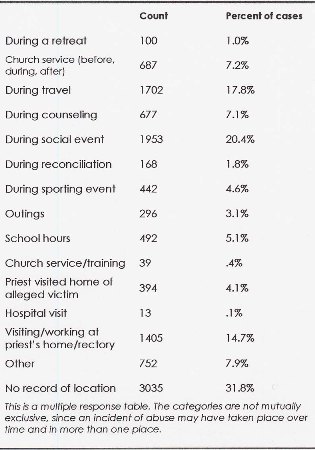 |
Table 4.5.5 indicates the relationship between the allegedly abusive priest and the family of his alleged victim. In a little less than half of the cases, no relationship was reported, but in just over one quarter of the cases, records indicated that the priest engaged in a social relationship with the alleged victim’s family.
Table 4.5.5 PRIEST/FAMILY SOCIAL RELATIONS
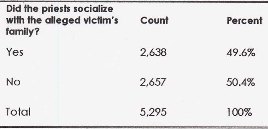 |
Table 4.5.6 describes the way in which the priests socialized with the families of their alleged victims. In cases where there was information in the records to indicate that the family of the child socialized with the priest, the majority of socializing, approximately 80%, reportedly occurred in the family’s home. A little under half off the socializing was reported to have occurred at the church or in activities sponsored by the Church. Records indicated that in almost a quarter of reported incidents, families socialized with the priest in his residence. It should be noted that these were not mutually exclusive categories, so many families saw the priest socially in one of several contexts.
Table 4.5.6 TYPE OF PRIEST/FAMILY SOCIALIZING
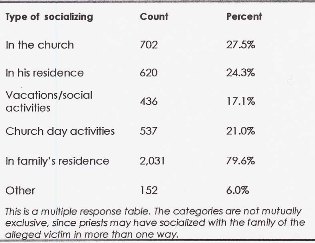 |
Table 4.5.7 describes the number of alleged victims whose siblings were also allegedly abused. This information was available in about 60% of reported cases. In 1,842 cases, or 29% of all surveys with a response to this question, siblings of the alleged victim were also alleged to have been abused by a priest. If this number is expressed as a percentage of all incidents of abuse reported in the study, 17% of victims reported abuse of a brother or sister by a priest.
Table 4.5.7 SIBLINGS ABUSED
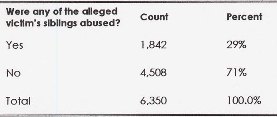 |
[Continue to Part
Five or return to Table of Contents.]